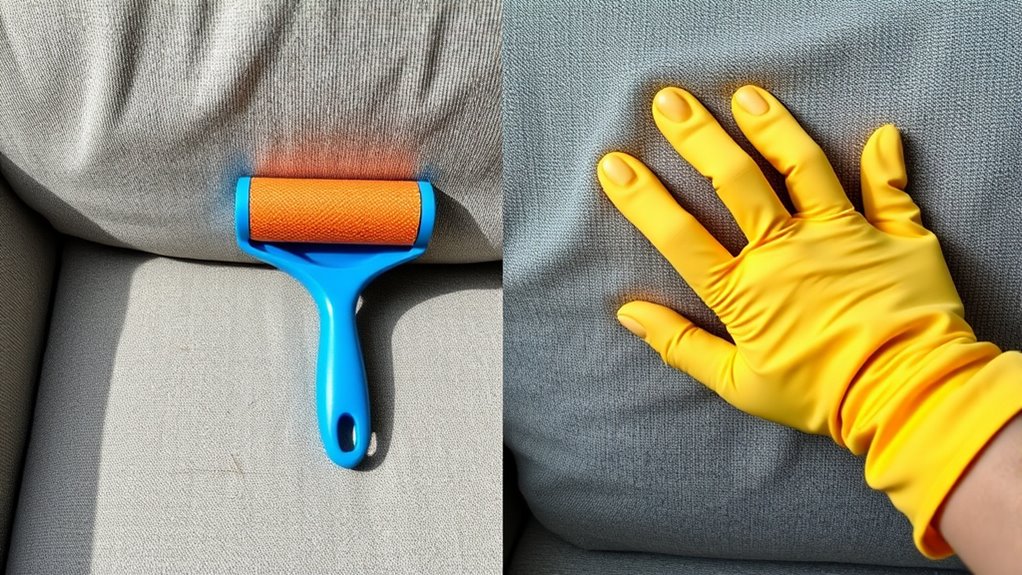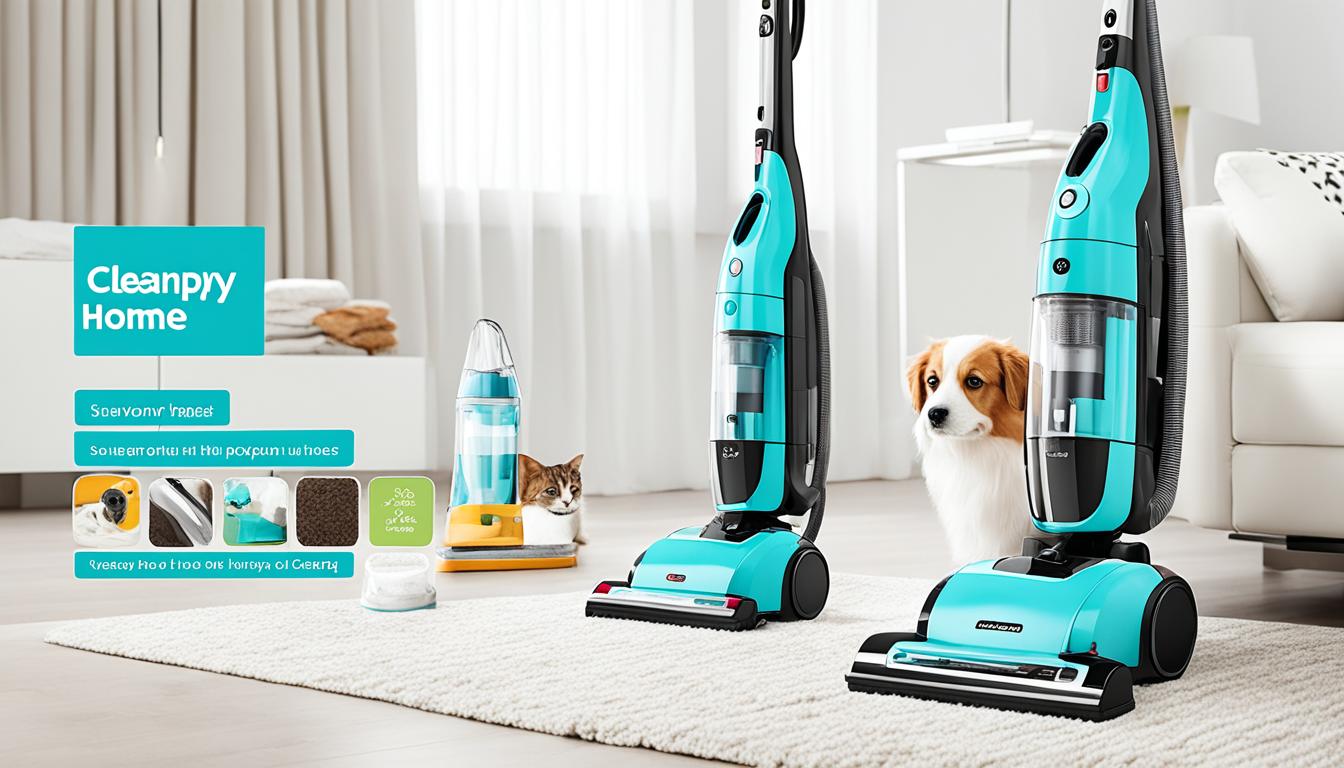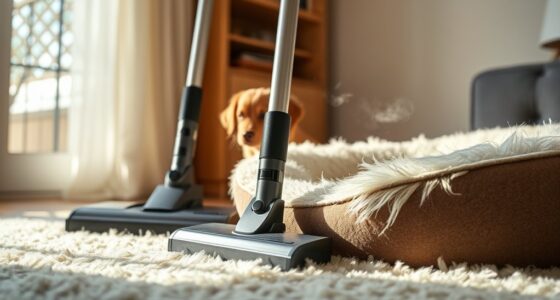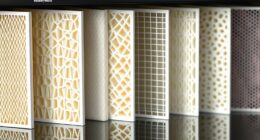Both lint rollers and rubber gloves effectively lift pet hair, but they excel in different ways. Lint rollers are great for quick surface cleanup and are convenient for clothes and furniture, though their adhesive sheets need frequent replacing. Rubber gloves, on the other hand, are reusable and work well for grooming pets and removing hair from large areas. To discover which method suits your needs best, keep exploring the details below.
Key Takeaways
- Lint rollers excel at removing pet hair from clothing and furniture with their adhesive sheets.
- Rubber gloves are highly effective for grooming pets and lifting hair from large, textured surfaces.
- Reusable rubber gloves are more cost-effective and environmentally friendly than disposable lint rollers.
- Lint rollers provide quick, surface-level cleanup, while rubber gloves offer controlled, targeted removal.
- Combining both tools maximizes pet hair removal efficiency across different surfaces and situations.
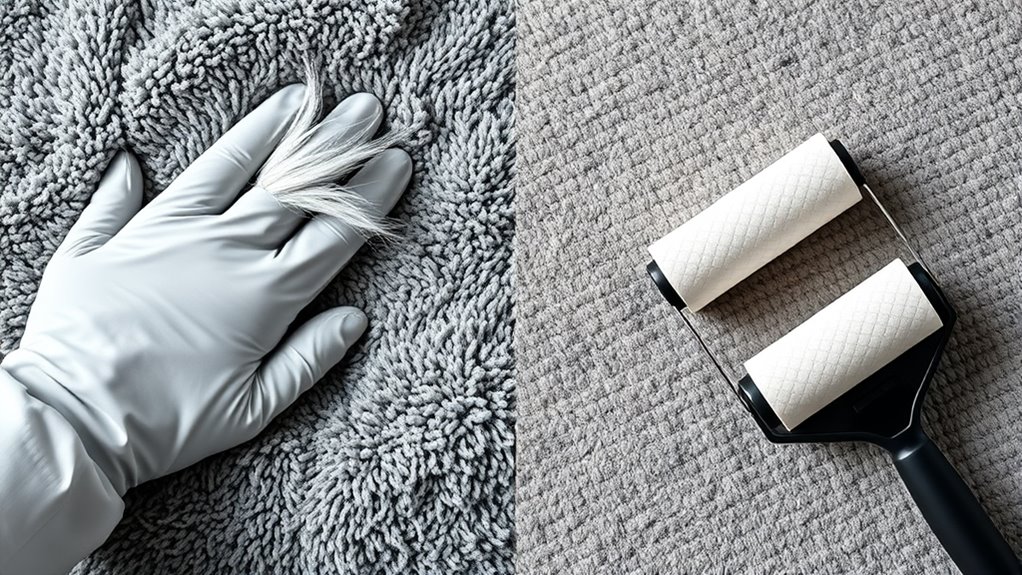
When it comes to removing pet hair, lint rollers and rubber gloves are two popular tools that can make the task easier. Whether you’re doing diy pet grooming or simply trying to keep your home clean, choosing the right method can significantly reduce pet hair around your space. If you suffer from allergies, selecting an effective hair removal technique becomes even more important, as it directly impacts your allergy relief techniques.
Lint rollers are quick and convenient. They feature adhesive sheets that pick up pet hair with minimal effort. You simply roll them over furniture, clothing, or pet beds, and the sticky surface traps hair effectively. This makes lint rollers perfect for on-the-go cleanup or quick touch-ups. However, they can become expensive over time since you need to replace the sheets frequently. Plus, they’re less environmentally friendly due to their disposable nature.
Lint rollers quickly remove pet hair but can be costly and wasteful over time.
Rubber gloves, on the other hand, are a more sustainable option. When you dampen a rubber glove and run your hand over upholstery or clothing, the rubber creates a static charge that pulls pet hair away. You can reuse the gloves multiple times, making them a cost-effective choice. They’re particularly good for large areas, like sofas or blankets, because you can cover more surface quickly. Rubber gloves also allow for more control, letting you target stubborn hair spots with a gentle scraping motion. This method is ideal for diy pet grooming, as it lets you groom your pet without additional tools or products, reducing stress for your furry friend.
Both tools have their advantages for allergy relief techniques. Removing pet hair effectively reduces airborne allergens, which is crucial if you or someone in your household suffers from pet allergies. Using rubber gloves can also be a more hygienic and eco-friendly approach, especially if you prefer reusable solutions. For best results, combine these methods with regular cleaning routines, like vacuuming with HEPA filters and washing pet bedding often. This comprehensive approach minimizes pet hair and dander, helping you breathe easier and maintain a cleaner home environment.
In the end, your choice depends on your specific needs. Lint rollers are excellent for quick, surface-level cleanup, but they cost more and generate waste. Rubber gloves offer a reusable, versatile alternative that’s great for larger tasks and diy grooming. Whichever you pick, consistent use will help you stay ahead of pet hair and allergy triggers, making your living space more comfortable for everyone.
Frequently Asked Questions
Can Rubber Gloves Remove Embedded Pet Hair More Effectively Than Lint Rollers?
Yes, rubber gloves can often remove embedded pet hair more effectively than lint rollers. When you wear the gloves and dampen them slightly, you create friction that lifts pet hair from surfaces, improving cleaning effectiveness. This method is especially handy for textured fabrics or stubborn hair. Plus, it’s reusable and eco-friendly, making it a practical choice for thorough pet hair removal around your home.
Are There Specific Pet Hair Types Better Suited for Lint Rollers?
Think of pet hair like a tangled ball of yarn—you’ll find certain types easier to pick up. Shorter fur and fine hair respond better to lint rollers, which act like a comb pulling loose fibers. Longer, thicker fur can be stubborn, sometimes requiring a rubber glove’s sticky surface to lift embedded hairs. So, match your tool to your pet’s fur texture and hair length for the best results.
How Long Do Lint Rollers Typically Last Before Needing Replacement?
Lint rollers usually last for about 30 to 60 uses before needing replacement, depending on their quality and the amount of pet hair they pick up. You should keep an eye on the durability lifespan—if the adhesive sheets lose stickiness or become clogged, it’s time for a replacement. To get the best results, replace your lint roller regularly to maintain efficiency and make cleaning pet hair easier.
Do Rubber Gloves Work Well on All Fabric Types?
Like a magic touch, rubber gloves work well on most fabric textures, but their effectiveness depends on glove flexibility. You’ll find they easily pick up pet hair on smooth surfaces, but rough or textured fabrics might challenge their grip. To maximize results, choose gloves with good elasticity, allowing you to adapt to different fabric types. Keep in mind, no method is perfect, but gloves offer a quick and reusable solution for many fabrics.
Is There a Hybrid Tool Combining Both Lint Roller and Glove Features?
Yes, there are hybrid tools that combine lint roller and glove features, offering dual function tools for efficient pet hair removal. These innovative pet hair removers let you easily switch between a sticky roller for quick pickups and a glove for targeted, detailed cleaning. By choosing one of these versatile options, you simplify your cleaning routine and effectively tackle pet hair on various fabrics without carrying multiple tools.
Conclusion
So, whether you’re team lint roller or rubber glove, it turns out neither’s perfect. You’d think pet hair would be an easy fix, but here we are, still battling those stubborn strands. Ironically, the tool that’s supposed to make your life easier might just leave you chasing stray hairs longer. Guess sometimes, the best solution is to accept the chaos—pet hair just has a knack for sticking around, no matter what you use.
